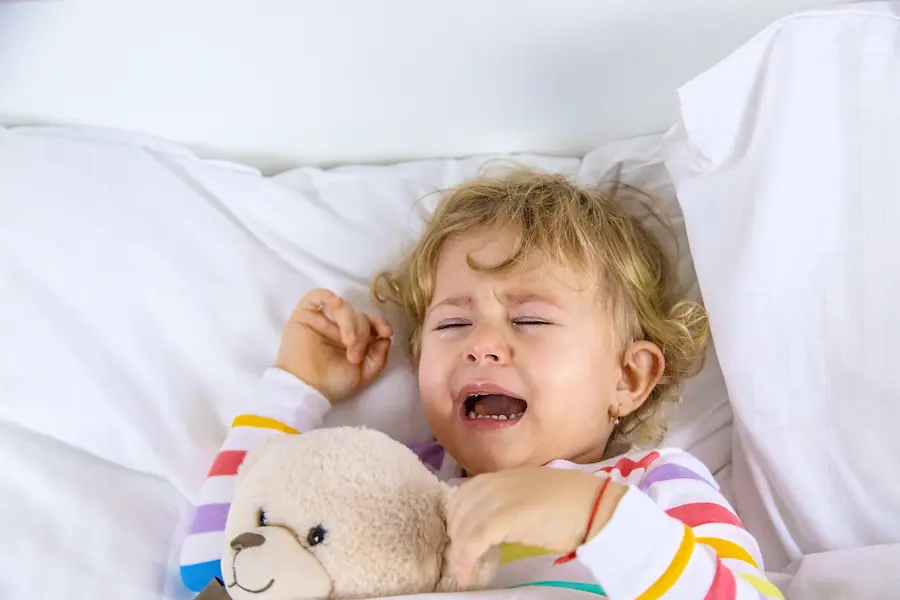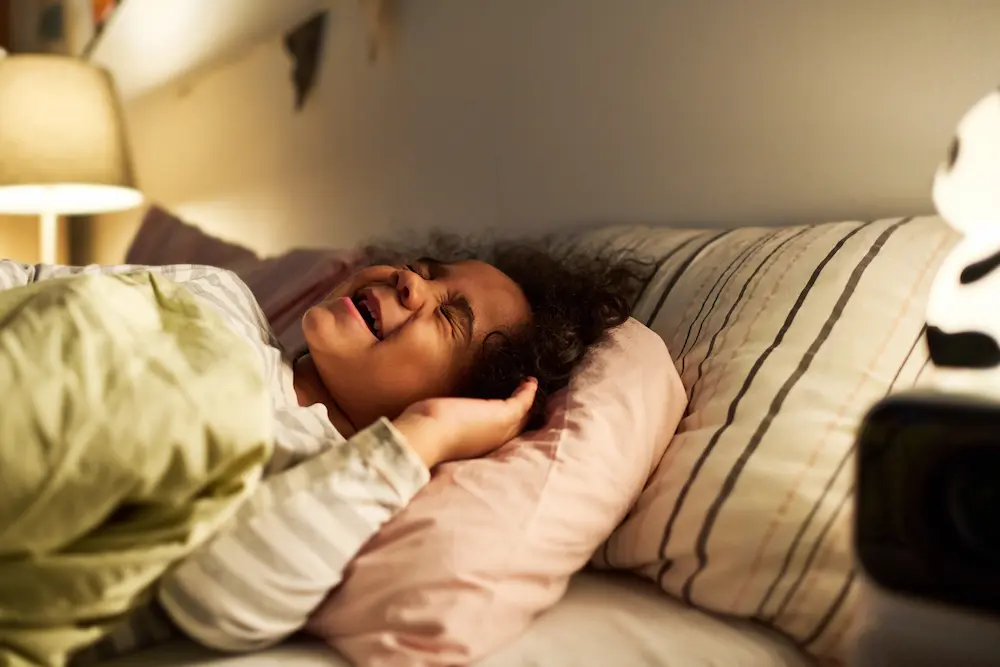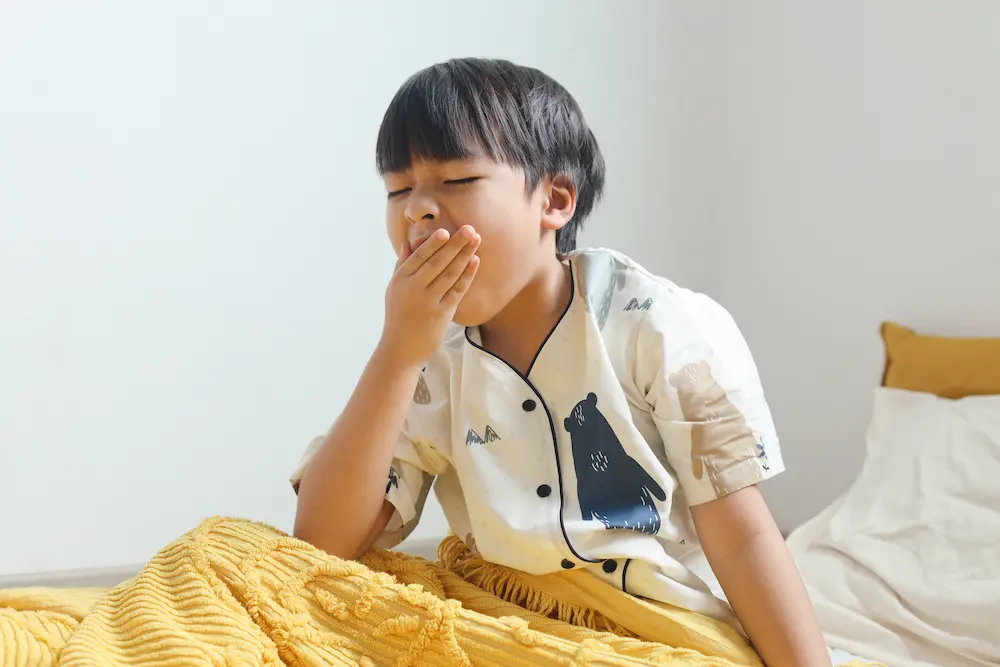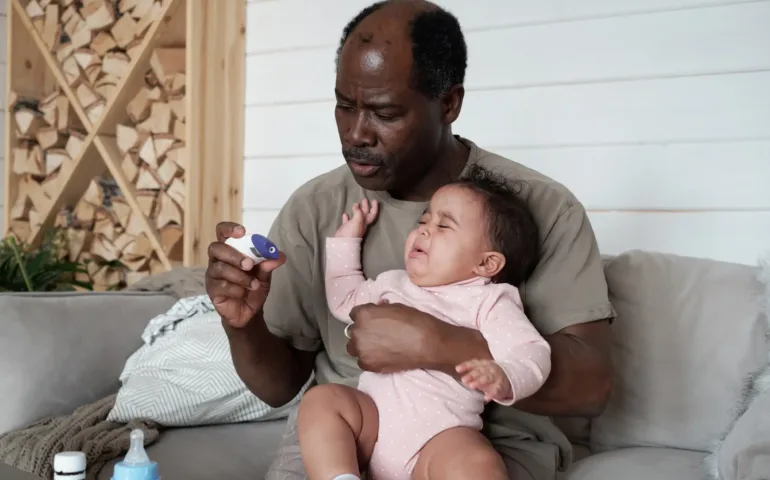
Night terrors are very common in children. While your child is sleeping peacefully, they suddenly start screaming and seem terrified. How can you tell the difference between a night terror and a simple nightmare? What exactly happens during this sleep phase?
Night terrors in children: let’s take a closer look.
What is a night terror?
Night terrors frequently affect children, often from the age of 18 months. Unlike nightmares, which occur during REM sleep, night terrors usually happen early in the night, during deep sleep. During these episodes, your child appears to be awake and terrified, while in reality, they are still asleep and cannot hear you.
Typical symptoms of night terrors
To recognize a night terror, here are the main signs:
- Partial awakening: your child may appear awake but is actually stuck between sleep and wakefulness. They are difficult to wake and do not respond to comforting attempts.
- Signs of panic: increased heart rate and breathing, sweating, and sometimes sudden crying or screaming.
- Your child is inconsolable: during a night terror, you will not be able to comfort your child despite your best efforts.
- No memory: unlike recurring nightmares, your child will generally have no memory of this episode upon waking.
These episodes can be disturbing for you, but in reality, they are often harmless and don’t last very long, and your child usually falls back asleep quickly afterward.
Good to know: it is recommended not to try to wake your child during a night terror, as this could make it harder for them to fall asleep again.
Night terror, sleepwalking, or restless legs syndrome?
Night terrors are often confused with nightmares, but they differ in nature and in their timing during the sleep cycle. Both are considered parasomnias, as are sleepwalking and confusional arousals.
Difference between night terrors and nightmares
Understanding the difference between a night terror and a nightmare helps you respond appropriately to your child’s sleep disturbances. While these two phenomena may seem similar, they differ in several ways.
Nightmares mainly occur during REM sleep, often toward the end of the night. During this sleep phase, your child may wake up, call out to you, and express their fear. They usually remember their nightmare, which may prevent them from falling back asleep. Recurring nightmares can lead to bedtime anxiety and sometimes mild insomnia.
On the other hand, night terrors occur early in the night, during deep sleep. During these episodes, your child seems to be in a confused sleep state with visible signs of panic, such as crying, screaming, and an increased heart rate and breathing. Unlike nightmares, your child is hard to wake and will not remember the episode upon waking. They usually fall back asleep quickly once the episode is over.

Causes of night terrors in children
Night terrors in children are impressive episodes that can leave parents feeling confused. Understanding the potential causes of these events can help reassure you. Several factors may contribute to the occurrence of night terrors:
- Genetic factors: parasomnias, including night terrors, can have a genetic component. If a parent experienced similar sleep disturbances during childhood, it is possible the child may inherit them as well.
- Stress and emotions: emotionally charged days or changes in daily routines can disrupt your child’s sleep cycle, increasing the risk of night terrors. A hectic schedule or significant life events may lead to insomnia or difficulties falling asleep.
- Underlying sleep disorders: children who suffer from sleep disorders such as sleepwalking may also be more prone to night terrors. These conditions can disrupt deep sleep, where night terrors typically occur.
- Neurological development: your child’s rapid brain development may play a role in the occurrence of night terrors. During this period, the brain is working hard, which can manifest as frequent awakenings and night terrors.
- Lack of sleep: a lack of sleep due to irregular schedules or recurring nightmares may also contribute to night terrors. Ensuring your child gets enough rest and has a stable bedtime routine can help reduce their frequency.
Although these episodes can be frightening, it’s important to remember that they are often harmless and that your child is deeply asleep during them. 
How to respond to a night terror
Night terrors can be impressive for parents, but it is important to stay calm and know how to react to help your child through these episodes. During a night terror, your child is actually asleep, even if they scream, thrash about, or seem terrified. Here are some practical tips for dealing with the situation:
- Don’t try to wake your child: while it may be instinctive, trying to wake your child during a night terror can make things worse. This could cause confusion and make it harder for them to fall asleep again.
- Stay calm and present: the best thing you can do is stay by their side. Your reassuring presence can help calm your child, even if they don’t seem to respond. Make sure their environment is safe to prevent injury during the episode.
- Ensure a safe environment: make sure your child’s bed and bedroom are safe by removing dangerous objects and ensuring they can’t fall out of bed or bump into anything.
- Wait for the episode to pass: night terrors are usually short-lived, often lasting between 1 and 10 minutes. Your child will continue sleeping and will not remember it afterward.
Remember, these episodes are often harmless and are part of common parasomnias in children.
Want to learn more? Feel free to download the May app, where you’ll find plenty of resources to support and guide you throughout your journey as a new parent.

Tips to prevent night terrors
Night terrors in children can be a source of concern for parents, but there are a few strategies you can put in place to try to reduce their frequency. Here are some practical tips to help your child sleep well and limit these disruptive episodes:
- Establish a soothing bedtime routine: you can create a calming and predictable bedtime ritual (saying goodnight to stuffed animals or family members, reading a story…). A stable routine helps your child mentally and physically prepare for sleep, reducing the risk of sleep disturbances.
- Ensure a safe and comfortable sleep environment: we recommend checking that your child’s bedroom is conducive to sleep. A quiet, dark room at a comfortable temperature promotes deep sleep.
- Manage stress and emotions: as mentioned earlier, emotionally charged days can disrupt sleep cycles. Encouraging calm activities before bed and talking with your child about their day can help reduce anxiety.
- Monitor nap times: an appropriate nap schedule can help prevent night terrors. Too much or too little daytime sleep can affect nighttime sleep. Try to maintain regular schedules and ensure naps take place in the early afternoon to avoid bedtime difficulties.

When should you consult a healthcare professional?
Night terrors in children are often harmless and usually do not require medical intervention. However, there are certain situations where it is advisable to consult a healthcare professional to ensure everything is fine and to receive appropriate support. Here are some signs that may prompt you to seek medical advice:
- Frequency and intensity of episodes: if night terrors are very frequent or particularly intense, disrupting your child’s sleep cycle and preventing regular deep sleep, it is wise to consult. A healthcare professional can assess whether a more complex sleep disorder is involved.
- Impact on daily life: when frequent awakenings and night terrors affect your child’s daytime behavior, such as difficulties concentrating, increased irritability, or signs of excessive fatigue, it is important to discuss it with a specialist. These signs may indicate that your child’s sleep is not restorative, which can impact their development and well-being.
- Presence of other symptoms: if night terrors are accompanied by other symptoms such as bedwetting, hallucinations, or sleepwalking, it is recommended to consult. These signs may indicate other sleep disorders or underlying medical conditions that require special attention.
- Recent changes or stress: periods of intense stress or major life changes, such as moving or the arrival of a new family member, can worsen night terrors. Professional support can help manage these transitions and soothe your child’s nights.
- Recommendations from school or other professionals: if teachers or other adults who interact daily with your child notice significant changes in their behavior or performance, it may be useful to consult to assess the impact of night terrors on their school and social life.
Night terrors in children are therefore impressive but generally harmless episodes, occurring mainly early in the night during deep sleep. Understanding the difference between these episodes and nightmares, which happen during REM sleep, is important for responding appropriately and helping your child sleep well. If night terrors become frequent or disrupt your child’s daily life, do not hesitate to consult a healthcare professional. 
**
Photos: YuriArcursPeopleimages | Pressmaster | yavdat | Raul_Mellado | yanadjana | Garakta-Studio
This text was translated from French by an artificial intelligence. The information, advice, and sources it contains comply with French standards and may therefore not apply to your situation. Make sure to complement this reading by visiting the May US/UK app and consulting the healthcare professionals who are supporting you.




